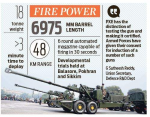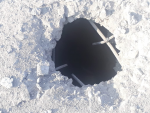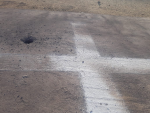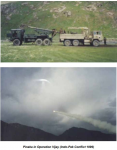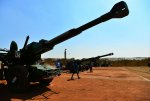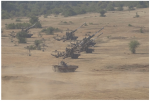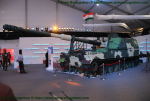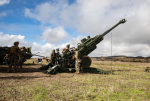@Ashwin @nair @Falcon @vstol Jockey @randomradio @_Anonymous_ @Sathya @Parthu @Milspec et al.
The Wider National Problem Beyond Pinaka
Lt Gen PR Shankar (Retd)
January 6, 2020
CHENNAI
 Photo : Guided Pinaka rocket in the recent test.
The Comment
Photo : Guided Pinaka rocket in the recent test.
The Comment
“Long range artillery aided with precision can be a suitable complement for air-power and lack of fighter sqns of the IAF. The precision and low cost should be enough for us to procure the same. The precision element included in long range rockets will also moderate the myth of rockets being area weapon with limited use due to higher collateral damage, especially in times when collateral damage is frowned upon. Pinaka is a better system than Smerch rockets in its ability to be upgraded and having latest technologies, more importantly, indigenously developed. Thus, the need of hour is to go in for long range precise rocket artillery which can swing across the bandwidth of gun artillery at one end and complementary to airpower at another thus reducing need of guns for contact battle and freeing up airpower for air superiority”. This response to my article ‘Pinaka in Conventional Non-Contact Deterrence’ is from an officer who commanded a Smerch Regiment when I was GOC of the Artillery Division. I think it is brilliant, precise and crisp in its conception. I will take it forward from there to widen the picture since there is a bigger problem which needs to be addressed.
Row Your Boats On Your Own
Despite Pakistan’s economic tatters and a Chinese economic slowdown their militaries are expanding and modernising, unabated. While our relationship with both our nuclear neighbours is increasingly adversarial, there is increasing collusion between them. The latest being that China is going to give 236 of the latest 155mm Howitzers to Pakistan. On the domestic front, societal events and upheavals are forcing our so-called ‘strategic’ friends and neighbours into a rethink mode to recalibrate their relationships with us. We need to be prepared to face international headwinds. Welcome to the world of realpolitik and increased threats. Be prepared to row your own boats.
Non-Contact Warfare And Long-Range Precision
The Chinese White Paper on defence lays tremendous focus on surveillance, firepower, extending ranges and standoff engagements. The U.S. has very clearly stated that Long Range Precision Fires is the highest priority and have funded programmes accordingly. They talk of Multi Domain Operations, Non-Contact Warfare and Standoff. So does our newly appointed CDS. In recent times, he has been speaking of Non-Contact Warfare in every possible forum. Beyond a point, Non-Contact Warfare involving violence must be executed by Artillery and Air Force only. That point is where Infantry and Tank ranges end.
Shrinking Military Budgets
Military budgets will stagnate or shrink in a slowing economy. There is no option but to modernise with tight budgets. We are also in an era of disruption and multi domain operations. War is changing without doubt and we must change accordingly. That means we need to spend more on new technologies. Budgets for that must also come from the already shrinking budgets! The finale is that if one thinks that less will be available for traditional hardware of conflict, he is bang on target. The noose is tightening. If you cannot think out of the box, be prepared to die within it.
The Himalayan Requirements
Turn to the Himalayas—our main and future battlefield as evident from the first thoughts of the COAS. The core capability we need is well-equipped Infantry to hold ground and devastating firepower to inflict damage on a sustained basis. Firepower means a strong Air Force and Artillery—short, medium and long-range firepower with annihilative capability despite taking a hit. To make firepower count, we need to force-multiply it with accurate surveillance and target acquisition capability. This implies that the arrowhead of our forces whose capabilities must be strengthened and sharpened revolves around Infantry, Artillery and Air Force. Any imbalance in their synergistic capacities will be at a national cost.
State of Infantry, Air Force And Artillery
Let us examine the Infantry, Air Force and Artillery. Our top-heavy Infantry leadership has failed to modernise its own arm—The Infantry. Expecting them to modernise the rest of the Army is far too much. That is a proven fact now. Infantry Generalship apart, our Infantrymen are the salt of the earth. They will fight to the last man, last round if the enemy and his firepower is kept off their backs. To do that we need a strong Air Force and Artillery which are complimentary to each other to deter the Chinese as also take them on if needed. The potency of IAF is plummeting with reducing number of squadrons even after considering future induction of Rafales and Sukhois and production of Tejas. Any new Request For Proposal (RFP) for any kind of fighters will have a time loop of 15-20 years. That is our record which cannot be shortened. Things will not improve overnight. In the meantime, China is busy upgrading airfields and its Air Force to out match us. Our air power edge is eroding. Our artillery is getting to be potent with a plethora of guns and missiles set to enter the fray. It has the potential to plug the loopholes which are palpably appearing due to the slow pace of Infantry modernization and the decreasing air power edge.
Pragmatic Options Vs Limited Thinking
Artillery is the low-cost option which can substitute air power to meet our national requirements in these hard economic times. Is artillery being positioned and developed accordingly? NO. We are caught in a situation where the IAF is unable to think beyond fighters and the Indian Army is not able to think beyond the infantry. Individual service capabilities based on narrow views have taken precedence over overarching national perspectives. The requirement of the defence establishment to work for a national perspective has clearly eluded us. The CDS must bridge this divide. Otherwise, we will pay a heavy price.
Force Division Vs Force Multiplication
Increasing range of engagement, having non-contact deterrence capability, substituting depleting air power with relatively low-cost artillery demands that we have adequate numbers. In 2008 we visualised a set of numbers for the Pinaka. When the national scenario demands more numbers, the Indian Army has reduced them! I have written about this ‘reverse gear’ phenomenon earlier. Further, efficacy of long-range artillery is linked with an inherent capability to seek, locate and destroy targets in depth. There is an essential link between sensors and shooters. Unless you have UAVs and long-range guns and rockets intimately linked and functioning as one, they cannot substitute air force. Without UAVs, long-range artillery, beyond visual range is like the blind ‘Dhritarashtra’ from The Mahabharat. Till now those links were the UAVs which were integral to the artillery. Recently, they were hived off. All the UAVs are to be handed over to the Army Aviation. The thinking and emphasis is that UAVs are for surveillance and the Army Aviation is better suited for it. From dual tasking, we have reduced the UAVs to a single-task situation in one stroke. Not only have we reduced the numbers but also have divided our capability. This is the prime example not of force multiplication but of force division.
Sensor to Shooter Links—Snapped Like A Twig
Once upon a time, the aerial sensor-shooter umbilical was the erstwhile air OP. They used to carry out observation duties. They were very effective and so were the guns. Their success is borne out in all operations. There was elan about the Air OP boys who carried out daredevil flying to destroy enemy. They were in sync with the guns. Many times, they were from or had affiliation with the regiments with which they were firing. These were both personal and professional. Ever since Army Aviation has come into being, this link has snapped like a twig. The Army Aviation with its grandiose imagination of being part of air mobile forces drifted away from artillery. In the process, artillery lost its cutting-edge over the hill capability of observation, liaison and communication to direct fire effectively through aviation. Today, these are peripheral tasks of Army Aviation and not practised. The Army Aviation is still full of glorious plans while effectively being air taxis. The Indian Army, by denying observation to its artillery is force dividing itself. It has done it once before with helicopters and is doing it again with UAVs. That is a pity to put it mildly.
Leadership and Generalship
Why is this happening? I ascribe it to poor leadership and decaying Generalship. I have already written that Generalship is sorely wanting in our context. An overdose and overemphasis of counter insurgency operations has propelled a crop of less than competent infantry officers to the top. Some of them have risen due to majoritarianism rather than cerebral and visionary ability. Largely, the Indian Army follows a caste system of promotion in which “the best might never reach the top, the worst have a fair chance of becoming top Generals. That happens often due to regimental affiliations, lanyarded views, old boy grids and bandwagonism. In my opinion this phenomenon has dropped deeper roots over the past decade”
. In turn, it has led to the marginalisation of the artillery and mechanised forces and ‘Infantrisation’ of Generals. The current system of ‘General Cadre’ is flawed and heavily biased. I have no problem with Infantry Generals at the top. The best of them are as good as any and I revere them. However, when the not-so-good are promoted to the top it is at the cost of marginalization of the best Artillery, Mech Forces and Sapper Officers. Further, if these lower merit Infantry Officers who have made the grade through other considerations are endowed with favorable astrology, date of birth and higher seniority on commissioning, they have become Army Commanders and Chiefs. The Indian Army leadership gets out of balance. Then, India must recognise that there is a problem. That is already showing up operationally in the way artillery is being viewed and handled. Look beyond to pay, perks and status erosion. Look at the break down in jointness and acrimonious inter-Service views which often surface. Look at the crawling pace of modernisation. Look at the politicisation of the Army leadership. Look at the Social Media and its views on Generals. Take peer and subordinate views. I will quote Bob Dylan as did the previous Air Chief: “the answer, my friend is blowing in the wind”.
A National Relook Is Mandated
If the Army leadership presides over force division either by default or design, how can synergy with IAF or IN develop to get a national doctrine or game plan going? In such conditions, no amount of budget allocation will suffice since a fool and his money are soon parted. In any case, too much of one thing is bad. The time has come to seriously take a relook at the promotion to higher ranks in the Army. Maybe, a
pro-rata system is not a bad option. Choose the best from each arm and you will have a balanced composition of professional Generals. There will be many views on this issue and many hackles will be raised. That is fine. It’s time to call a spade a spade. When Infantry Generals aspire for a rifle with two barrels; which does not exist in the world, and want infantry to man and command strategic missile units instead of artillery which has developed and raised them from scratch, I think the nation needs to rethink very seriously on the Generalship ability of some of them. This is a national issue and not merely an internal issue of the Army, Air Force or Navy anymore. I also think that the time has now come to shed the counter-insurgency orientation of the Army. The boots-on-the-ground approach which has dominated our thinking needs a serious rethink. A subtle change is happening.
(Lt Gen. PR Shankar (retired) put Indian Artillery on a firm path of modernisation. He is presently a professor in Aerospace Department of IIT Madras. Views expressed in this article are personal.)
The Wider National Problem Beyond Pinaka – Strategic News Global
The general presents an interesting prespective. Some of the criticisms of the IA's leadership are well deserved especially with infantry modernisation and too much focus on CI/CT ops. Some others like lack of UAV recon seems a bit off given the recent use of UAVs to aid Arty on the LoC. We could do better of course but to say our UAV recon is absent and the edge is eroding away seems a bit much. Is it necessary for Arty regiments to have UAVs to access info from UAV recon flights ? Is there no other means of live info transfer between Arty regimnts and Army Aviation ?
Also what is thhis pro-rata system he speaks of ?
 Hope everything speeds up... as the Army needs 1500 - 2000 of these. Any idea about 400 ATHOS 52 caliber pieces... being bought... There has been no news, after the initial report that Elbit - Bharat forge have emerged as the winners...
Hope everything speeds up... as the Army needs 1500 - 2000 of these. Any idea about 400 ATHOS 52 caliber pieces... being bought... There has been no news, after the initial report that Elbit - Bharat forge have emerged as the winners...

